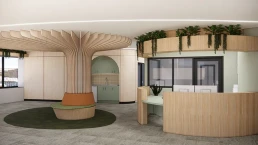Caring for ourselves as we co-design for mental health
Client: ClarkeHopkinsClarke Architects
Services: Co-writing and Ghost Writing
Caring for ourselves while facing challenging project demands and deadlines is a continuous balancing act. Stephanie Clarke shares insights about personal care, mental health awareness, imperfect activism and key lessons learned when working in the co-design of mental health spaces.
The final report of the Royal Commission into Victoria’s Mental Health System was handed down in February 2021. Highlighting years of under-resourcing and systemic failures, it outlined 65 recommendations for improvement. In the wake of the report I have worked on some of the first mental health facilities developed in response, including Barwon Health’s Central Geelong Mental Health Hub. Learning how to co-design in this context has been a revelation – personally and professionally, in ways I could never have fully anticipated.
The pandemic has vastly increased the numbers of people experiencing and talking about mental health – in Australia and globally. This has helped to destigmatise mental health, but it also increased demand for services in an under-resourced system. After the Royal Commission, we were seeing increased funding and systemic change aimed at creating a more integrated, community-based system, where people can access health and wellbeing services close to home, work, family and other support.
We co-designed the Central Geelong Mental Health Hub with people with lived experience and clinicians, centring their experiences and insights. Designers who previously led user-engagement on projects were adjusting to the new reality of needing to earn their invitations into those discussions.

Read more:
https://parlour.org.au/mental-wellbeing/caring-for-ourselves-as-we-co-design-for-mental-health/